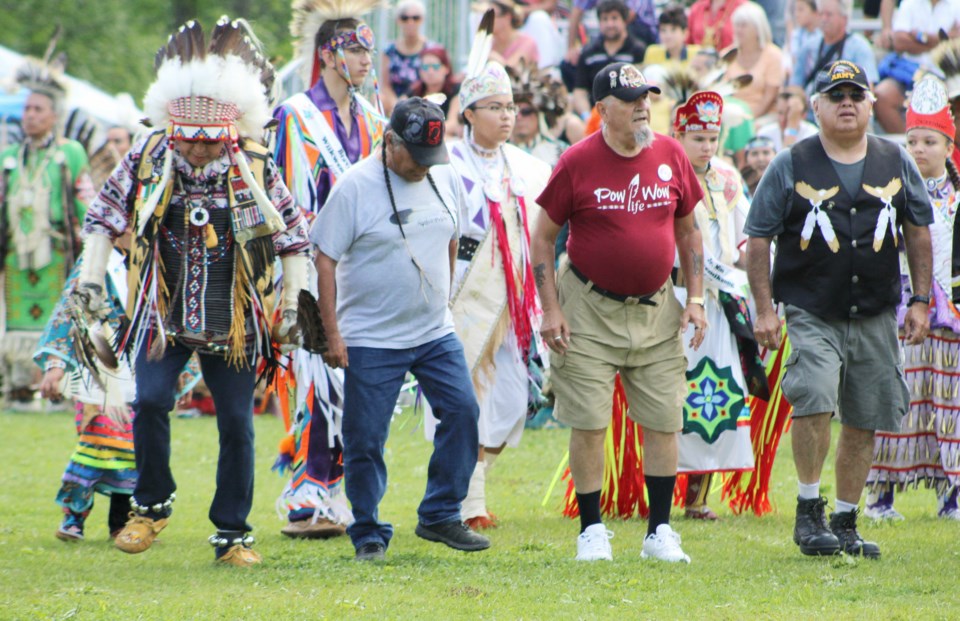There’s always a mild tension in the air as everyone awaits Grand Entry at a powwow.
Dancers young and old adjust, fasten, and unfasten straps, strings, beads, feathers, as last-minute touches are made to their regalia. Jingle dresses jingle as women walk quickly past, working their way to those assembling at the eastern doorway/entrance of the powwow dance arena. Dancers fidget one last time with regalia within this flowing assembly of brightly coloured beads and feathers with each piece vying to capture the eye of an ever-growing throng of spectators.
Finally, as the sun reaches its highest point in the blue sky above, the arena director raises his arm and calls for the Grand Entry to begin. Flags and eagle staffs (the first flags of the land) are lifted and carried by veterans, chiefs and other dignitaries. The powwow masters of ceremony call for the host drum to sing an honour song and the entire procession enters the dance arena. And they dance their way clockwise around the circular arbour that shelters the drum groups. They travel in the same direction the sun does as it enters our time and space each day.
This is how the modern-day powwow begins.
The powwow is a mixture of celebration and ceremony, just as it has always been for thousands of years here on Turtle Island (North America). But there was a time when it was not practised. There was a time when the European settler community made it an offence in their law books to hold a powwow gathering. They recognized how important it was to Indigenous people and how the powwow passed on traditions and teachings to new generations.
This tradition needed to be severed as it countered the assimilation and Christianization of the Indigenous peoples. So, from the late 1880s until the early 1950s, the traditional practice of the powwow was banned. The tradition of the powwow was taken underground and hidden away from Indian agents and RCMP or the clerical leaders. Each First Nation community has stories of the dances and songs and drumming being secretly passed on deep in the faraway corners of the forests surrounding reserve lands.
But even after it was no longer against the law according to the judiciary, the clerical community from each religion forbade the practice.
The modern-day powwow was born from ingenious minds who realized the settler community was drawn to Indigenous cultural items that were colourful and pleasing to the eye. So, they created dance troupes that would go out into the Indigenous towns and cities to perform for non-Native crowds. I remember as a young boy of seven being a part of such a troupe. We were invited to dance, drum and sing throughout Simcoe County. I distinctly remember performing at Zellers parking lots in Midland and Orillia and seeing our dance troupe billed last on the poster, just behind the alligator wrestler. Yes, the alligator wrestler.
It was an important time, and I was introduced to our culture and teachings in a way my ancestors had done for thousands of years before. Through traditional dance and song, we discovered who we were.
It was in makeshift dance arenas like this that Indigenous people began to revive forbidden culture into their lives. Many of the regalia and dances we see today, like the fancy dancers, the jingle dress dancers, and dances like the round dance and the bacon dance, were created as entertainment for non-Indigenous people as we secretly passed on the teachings within those settings.
My mother was a residential school survivor, and like so many other survivors, she had internalized the loathing that the clerical community had for Indigenous people. She was taught that our customs, language and traditions were the work of the devil. She learned to refer to our songs and drumming as the devil’s music (and here I thought it was the Rolling Stones).
The powwow didn’t make a comeback into most Indigenous communities until the 1970s. The trail back to the powwow was bumpy, harsh. Clergy-led congregations stood in the way. In my community, it took countless community meetings before the powwow prevailed. And the first powwow in more than 100 years did much for young people who were able to celebrate who they were. The sense of joy, the laughter, the sense of togetherness everyone experienced that first time as Indigenous people mingled together for two days of celebration and did much for the soul. The resulting spiritual healing was felt until the following year, when you could fill your soul once more.
Freedom is when you can practise your culture and learn your teachings without interference. We did not have that freedom for decades. It is freeing to don regalia and dance with the ancestors and celebrate our continued existence.
Oh, and that mild tension? It will always be there. It is the residue from a time when we had to hide our culture from a society that wanted to eliminate us. We can’t be sure it won’t happen again.
Jeff Monague is a former chief of the Beausoleil First Nation on Christian Island, former treaty research director with the Anishnabek (Union of Ontario Indians), and veteran of the Canadian Forces. Monague, who taught the Ojibwe language with the Simcoe County District School Board and Georgian College, is the superintendent of Springwater Provincial Park.



